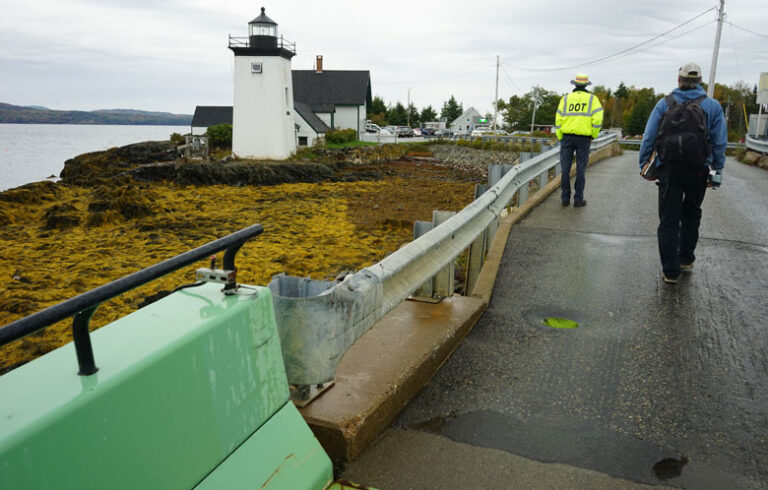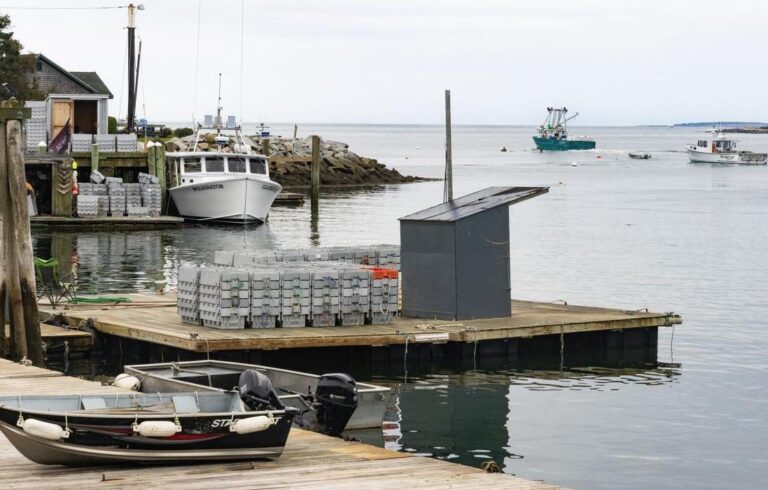Moose Island Marine on Deep Cove Road in Eastport, writes painter Lora Whelan, “is a wonderful place to walk by, with clanging lines on the masts, the sounds of boatyard work going on, and all those different boats up on supports to admire.”
One day, while recording some of those mast line sounds for a niece, “a musician who uses found sounds,” Whelan photographed some draggers, drawn by their connection to the lives of local fishermen. As she did so, she felt something “looming” behind her. Looking up and back, she found the yard’s 60-ton travel lift towering over her.
The painting “Travel Lift, Moose Island” captures that dramatic perspective Whelan evokes. A mighty triangle of crane, cables and winches—like the arch of a marine cathedral—reaches into the sky.
She exhibited abstracted views of blueberry barrens, clam flats, and the solar eclipse…
“If you like industrial equipment, and I certainly do,” Whelan writes, “a travel lift is hard to resist.” She calls it “the lifeblood” of a boatyard, moving vessels from the water onto land. “I had never given it a good look-see to understand how it worked,” she relates, “so I did, took photos, and decided I needed to paint it.” She adds, “They are very cool pieces of machinery.”
The painting is part of Whelan’s “Echoes of Place” series, shown at the Eastport Arts Center this past summer. She exhibited abstracted views of blueberry barrens, clam flats, and the solar eclipse along with more representational works, such as the travel lift painting and renderings of draggers, wharf remnants, and the smoke house in Lubec.
She hoped these images “of our beloved landscape and built environment” would resonate “for different reasons with different viewers.”

Whelan’s journey to Eastport began on the Upper East Side of New York City where, in the 1960s and ‘70s, her family lived on the edge of Spanish Harlem, in a rich mix of cultures. She recalls a contingent of Hell’s Angels one block away and youth gangs roaming Central Park, but also small neighborhood stores “run by owners we knew by name or who knew our faces.”
With a “fair amount of autonomy,” Whelan and her siblings explored the neighborhood, mesmerized by “the changing landscapes of human work and lifestyle.” She also spent time on her grandmother’s farm in Vermont, “a blissful change” that ultimately shaped her understanding of the kind of environment she needed, “with the space and quiet to think and work.”
Whelan went on to receive a BA. in creative writing at Bennington College where she also dabbled in electronic music. At Mercy College, she earned an M.S. in organizational leadership and development, a degree that came in handy when she moved to Maine to work for Eastport for Pride, a new Main Street Maine historic preservation program.
Around 2007 Whelan joined the staff of The Quoddy Tides newspaper. She has worked nearly every job there: copy editor, full-time reporter, and “employee of all works,” including driver and bookkeeper. “On one day I’d be zooming down to Machias to attend a county commissioners’ meeting, then up to Calais for a council meeting, then back to Eastport to write or edit,” she recalls.
Working for a community newspaper, Whelan notes, can be all-consuming and, by its nature, tightly rule based.
“You also suppress many of your own beliefs and opinions in order to listen and record accurately,” she writes.
In response to this intense job, in 2014 Whelan decided to teach herself to paint, with the only parameter being that this work was to be entirely for herself—“anything could go, no other rules and no lessons.” What she hoped would be “a joyful exploration” continues to be so ten years later. “I cleared a space by the front door, tacked paper up on the wall, and started with chalk pastels.”
From pastels, Whelan moved to oil but soon discovered that in a small house with limited space the drying time made the medium “difficult.” She found herself rushing it, “turning colors to mud,” so she switched to acrylic, which dries fast but also allows for some “play” as regards absorption and evaporation.
In January, Whelan pulled back from her editing and writing roles with the newspaper. These days she mostly focuses on the publisher function, “which doesn’t have that much to do with my artwork.” That said, her reporting has been instrumental in her painting.
“Almost 20 years’ worth of attending Eastport City Council meetings, not to mention the countless other municipal and county meetings, human interest stories, articles about energy, climate change and more,” she writes, “sharpened my eyes to what’s around me.”
Whelan’s decision to paint coincided with a blossoming art scene in Eastport. She points to the city’s long history of the arts, from the Passamaquoddy’s rich cultural traditions to back-to-the-landers who arrived in the 1970s seeking inexpensive places where they could pursue art and other endeavors.
The Eastport Arts Center, now almost 40 years old, “was the result of many of those people in the ‘70s who moved here,” Whelan explains. “They created a ground up approach to the arts by providing a nonprofit home for people with an interest in a specific area of the arts, such as a choral group or theater, to form, rehearse, and perform.”
The founding of the Tides Institute and Museum of Art more than 20 years ago expanded the city’s cultural offerings through artist residencies, educational programs, and exhibitions of established and emerging artists with connections and/or artwork of the region.
All these happenings, Whelan notes, “helped to develop a city that continues to mix an active working waterfront with an active arts community.” Her paintings reflect this dynamic combination.
Whelan is represented by Full Fathom Five Gallery in Eastport and Gallery Sitka in Shirley, Mass, and Newport, R.I. You can see more of work on her website, www.lorawhelanart.com.





